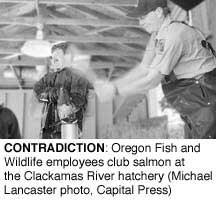forum
library
tutorial
contact

Killing Salmon to Save the Species
by Mike StarkHigh Country News, October 9, 2000
|
the film forum library tutorial contact |

|
Killing Salmon to Save the Speciesby Mike StarkHigh Country News, October 9, 2000 |
Critics say hatchery reform takes the wrong tack
 For many Northwesterners, the videotaped scene was shocking: Baseball bats flying, five Oregon hatchery workers clubbed hundreds of coho salmon to death. Ronald Yechout, a rural Oregon banker, caught the scene on tape during an elk-hunting trip with friends. He was outraged that Oregon Fish and Wildlife workers were killing fish despite the constant cry that Pacific Northwest salmon are heading toward oblivion.
For many Northwesterners, the videotaped scene was shocking: Baseball bats flying, five Oregon hatchery workers clubbed hundreds of coho salmon to death. Ronald Yechout, a rural Oregon banker, caught the scene on tape during an elk-hunting trip with friends. He was outraged that Oregon Fish and Wildlife workers were killing fish despite the constant cry that Pacific Northwest salmon are heading toward oblivion.
"It made me madder than hell," he told the Oregonian last March. "All we hear, over and over, is our fish are going extinct. The state is out there, killing them by the thousands."
To rouse people, he showed the tape to anyone who would watch, including civic groups, state lawmakers and local news stations.
But few people were outraged.
Biologists, fishery managers, environmental groups and sport fishermen weren't upset because killing excess hatchery fish is a common practice. When more farm fish return to the hatchery than are needed for eggs and semen for the next generation, the fish are killed to prevent them from breeding with wild fish and weakening native stocks. Many say clubbing salmon is the most humane way to kill the fish.
Although the clubbing flare-up didn't last long - and some said Yechout and other critics were property-rights advocates trying to ease land restrictions aimed at protecting salmon - it managed to put the debate over hatcheries back in the mainstream.
For decades, hatchery fish have been used to boost stumbling salmon runs and give anglers something to catch. But many argue that captive-bred fish weaken the biological integrity of wild salmon and also allow state and federal agencies to sidestep the real issue: repairing river habitat. In light of the Clinton administration's recently released salmon recovery plan, clarifying the purpose of hatcheries is critical (HCN, 8/28/00: The latest salmon plan heads toward a train wreck).
Many hats for hatcheries
Hatcheries in the Northwest came on the scene more than 120 years ago, and even well into the 1970s, hatchery managers thought that farmed fish were an equal trade for declining or absent wild fish.
"Hatcheries were thought of as meat-production facilities and they did that admirably," says Brian Gorman, a spokesman for the National Marine Fisheries Service. "But we have become considerably more enlightened since the 1960s and "70s."
Because hatchery fish are raised in an artificial environment, their survival skills aren't equal to those of native fish. Gorman says a hatchery fish may spot the shadow of a fish-eating bird on the surface of the water and move toward it, thinking it's feeding time. And it is - for the bird.
Hatchery fish also compete with native fish for food and habitat. Allowing wild fish to breed with hatchery fish weakens their genetic ability to survive and can make them more susceptible to bacterial kidney disease. Gorman worries that weaknesses introduced by hatchery fish could drive salmon closer to extinction.
A shift for salmon
"People were trying to do too much with hatcheries, to have salmon without rivers," says Chris Zimmer of Save Our Wild Salmon, a Seattle-based group. "But hatcheries just haven't made up for habitat destruction."
Now the government seems to agree. Gorman says NMFS is making a philosophical shift from using hatcheries as production facilities to turning hatcheries into places that supplement wild fish without overwhelming them. To avoid competition, managers are asked to release fewer farm fish, and to release them when wild salmon aren't around.
The Northwest Power Planning Council, a four-state group that oversees electric power systems and wildlife recovery in the Columbia Basin, is also creating new standards for hatchery management. Under the new guidelines, managers will be asked to show that their stocks aren't harming wild fish.
The council plans to use the new performance standards to determine which hatcheries are funded.
The council is right to call for more accountability, says conservationist Bill Bakke, director of the Native Fish Society. Government agencies and others have become overly dependent on hatcheries as a source of revenue and, he says, that clouds the kind of objectivity that's needed to examine the role hatcheries play.
But some tribes in the Northwest don't support how hatcheries are changing. Charles Hudson, a spokesman for the Columbia River Inter-Tribal Fish Commission, calls the concern for keeping wild and hatchery fish separate "a paper chase for a genetic ghost."
Hudson says, "Hatcheries should (act) to rebuild salmon populations until natural habitat is restored.
"We desire to build one strong run of fish in each stream rather than the perpetual dual system of one weak wild stock and a hatchery component," says Hudson. "Dual stock management is a dinosaur."
Northwest scientist Jim Lichatowich also thinks relying primarily on hatchery reform is the wrong tack for saving salmon. Lichatowich, who has studied fish for 29 years, says people talk about hatchery reform, but continue to deny reality:
"If we are to recover the salmon, we need healthy rivers," Lichatowich wrote in Salmon Without Rivers. "We must give back to the salmon some of their habitat."
learn more on topics covered in the film
see the video
read the script
learn the songs
discussion forum
